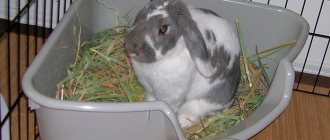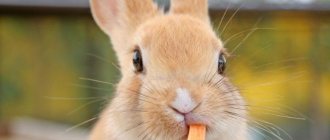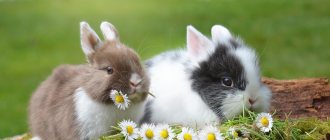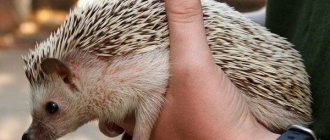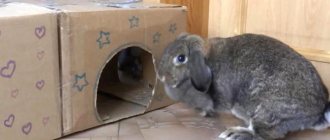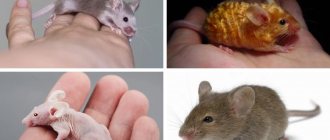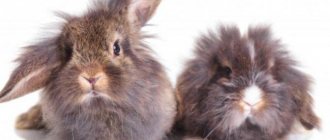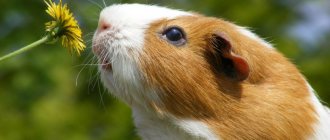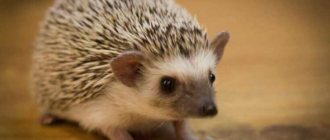Nail trimming is an essential part of caring for your pet rabbit. Some breeders, due to inexperience, believe that trimming is unnecessary or may harm the animal. But this opinion is wrong, because such a procedure, on the contrary, prevents uncontrolled growth and possible problems with the movement of the animal. Haircuts can be carried out at grooming centers or veterinary centers. But if you know some of the nuances, you can even trim your rabbit’s claws at home yourself, and at the same time save money on salon procedures.
Should a rabbit's nails be trimmed?
Wild rabbits' claws grow quickly.
This feature makes it possible to dig the ground to make holes and look for food. In the process of life, the nails of animals gradually wear down and are renewed. The domestic rabbit, regardless of breed, is also characterized by constant physiological growth of claws. But he does not have the opportunity to constantly move and dig something, which means that the claws of an ornamental pet grow, but do not grind down and cause the animal a lot of trouble. Therefore, the only correct decision in such a situation is to help the animal and cut its nails.
How to trim a rabbit's claws at home: necessary medications
The domestic rabbit, unlike its wild counterparts, needs its claws trimmed. The procedure should be carried out regularly, once every 3–6 weeks. The frequency depends on the activity of the pet and the natural grinding of the claws.
Did you know? Wild rabbits produce a semblance of domestic haircuts on their own, grinding their claws on branches, stones and bark. A decorative pet needs the help of its owners.
Benefit
- Among the advantages are the following:
- prevention of toe deformation;
- ensuring comfortable movement;
- eliminating the risk of tearing out or damaging the nail;
- correct distribution of the load on the animal’s body.
- However, this procedure also has several disadvantages, which include:
- the possibility of injuring your pet;
- infection due to insufficient processing of instruments;
- harm to the animal due to improper fixation;
- stress due to inept or painful trimming.
In addition to clippers, to trim a rabbit's claws you will need:
- brilliant green;
- iodine;
- hydrogen peroxide.
Such drugs are useful in case of injury to the animal. Also, before cutting, be sure to prepare a disinfectant solution for the clippers. This could be, for example, regular medical alcohol.
Actually, this procedure itself looks like this:
- the nippers are disinfected and brought to the animal parallel to its paw;
- grab dead particles of the nail plate with pliers;
- bite off part of the claw with the tool.
When cutting, it is very important not to damage the pulp. Before biting off a claw, it is advisable to look at the light.
The location of the pulp will most likely be clearly visible
If this part is not visible in the light, only the very tips of the rabbit’s claws should be trimmed. Under no circumstances should you damage the pulp when cutting. Otherwise the animal will lose a lot of blood
The location of the pulp will most likely be clearly visible. If this part is not visible in the light, only the very tips of the rabbit’s claws should be trimmed. Under no circumstances should you damage the pulp when cutting. Otherwise, the animal will lose a lot of blood.
The procedure must begin when the animal is 5 months old. Sometimes, even at three months of age, rabbits grow long claws. To carry out a haircut you need patience and time. The main thing is not to neglect the animal and carry out this procedure periodically. You will also need special tools for such manipulation.
The first nail cutting can be done with ordinary nail scissors, since the nail plate is not hard. Over time, it becomes rougher and cannot be cut with ordinary manicure scissors. This can lead to claw injury (cracks, breaks). A nail that is cracked causes a lot of problems for a rabbit.
Tools
This procedure takes place approximately once a month. You will need a tool: a guillotine nail clipper. The rabbit's claws are placed in a special round hole and the handle is squeezed, after which the blade quickly cuts it off. Special pedicure nippers with a good blade
It is important that the tools are sharp and that the handles are rubberized and do not slip out of your hands.
What tools can you use?
There are special nail clippers for trimming cat claws. It is not recommended to use nail scissors. They are designed for thin and flat nail plates of people. Such cutting tools lead to delamination.
There are several types of nail clippers:
- Blisters - resemble nail scissors, but have blades curved at the ends, designed for cat claws.
- Secateurs are equipped with a spring, which is located between the handles. As a rule, such models have a limiter. It allows you to cut only the desired length.
- Guillotines are similar to cigar scissors. The nail is placed in the hole at the end. When the handles are closed, the blade lowers and cuts the claw. The tool is suitable for cats with thick nail plates.
Each owner chooses the model that is convenient for him to use. The main thing is that it is made of high-quality materials and sharpened.
Additionally, you can buy an electric trimmer that allows you to quickly trim your nails. However, not all cats react calmly to it - the buzzing device scares the animals.
How to properly trim a pet rabbit's claws?
In its natural environment, a rabbit needs its claws to cling to the soil. Pets have to move on a flat surface, in which case they only get in the way. Under natural conditions, claws wear down naturally, but at home this is not possible.
The reasons for trimming rabbits' claws are as follows:
Overgrown claws prevent the long-eared animal from evenly distributing weight on its paws while moving. The weight is mainly in the heels. As a result, calluses appear on the heels or the pads become bald and purulent wounds form, and the toes may become bent. With its long claws, a rabbit can injure someone or injure itself when it itches. In addition, the growing nail plate begins to curl and bend. Claws that are too long can cause injury. If a rabbit gets caught with them, for example, on a carpet, it can break or tear out a claw, and in a bad outcome, break a finger. A sign of the need for a haircut can be the behavior of a rabbit if it begins to chew its claws.
Therefore, it is necessary to trim the claws regularly as they grow. Each animal's claws grow differently: for some they grow in a month, for others in three.
How to carry out the procedure?
Nail trimming begins at 3 months of age
It is important to take special care when grooming for the first time so as not to frighten or hurt your pet. Gradually he will get used to the procedure and will react calmly
Tool selection
If the nails are being cut for the first time and are still soft, then you can use nail scissors, which are usually used to cut nails. But later the claws become harder and you cannot use scissors for manicure, since they will not cut the claw right away, but will only crumble the nail plate and form cracks. This will cause trouble for your pet later.
To trim claws, you need to prepare special tools. These can be pedicure clippers with a wide slot or nail clippers. There are two types of nail clippers:
- in the form of a guillotine;
- special cutters with a limiter.
The blades of the devices must be made of steel, well sharpened and fit tightly to each other. Scissors should have rubber handles to prevent them from slipping out of your hands.
Rules for the procedure
Before the procedure, all instruments should be disinfected. Then you need to choose the position in which the pet will be. If the rabbit is calm and allows itself to be placed on its back, then it is more convenient to carry out the procedure in this position.
Having placed the animal on the table or on your feet, you need to fix the body with your left hand and with the same hand take the paw for processing. In this case, the rabbit's head should be under the elbow.
For better access to the claw, lightly press the pad. You need to trim claws in a calm environment, without getting nervous, so as not to scare the animal.
A special tool is used to cut off the dead part parallel to the foot.
It is important at this moment not to catch the soft tissue - the pulp, which contains the blood vessel and nerve ending. Before cutting, you need to carefully inspect the claw
You need to leave 3 mm to the pulp - this is the optimal length.
If the claw is too short, it will be painful for your pet to step on its paw. The video clearly shows what length to leave.
If it was not possible to place the rabbit on its back, you can ask an assistant to hold it, securely fixing its paws.
If you don’t have an assistant, you can use a diaper and wrap the eared one in it.
By freeing each paw in turn, you can safely trim the claws. In this case, the rabbit will not be able to injure either itself or its owner. Nails should be trimmed in one procedure. In total, 18 claws will need to be trimmed.
Sorry, there are no surveys available at this time.
First aid if a capillary is damaged
During the procedure, it is possible that the pulp will be affected and bleeding will begin. You should always have cotton swabs, streptocide, hydrogen peroxide, brilliant green or iodine on hand.
If, due to inexperience, the pulp is touched and blood begins to flow, then the procedure should be stopped and the wound treated with an antiseptic. Then it is advisable to sprinkle a crushed streptocide tablet onto the wound.
It has an antiseptic effect and stops bleeding. You can return the animal to the cage if the bleeding has stopped.
After the procedure, you should not let your decorative rabbit onto a dirty floor, as dirt will get into microcracks, which can cause infection or fungus. The animal's cage and potty should be disinfected with vinegar. When all the claws are shortened, you can reward the rabbit with something tasty and hold it in your arms for a while until it calms down.
Fixation
There are several ways to restrain a rabbit before trimming its claws. We will look at the best of them now.
- Fixation in a supine position. But this method will only be effective if the animal is accustomed to this position from a young age. In other cases, the animal usually breaks out.
- Fixation in a sitting position on a table. To do this, you need to place the eared one on the edge of the table, to your left. With your elbow, carefully grasp it and lean it against you. The slight tightness reminds him of being in a hole, so he usually calms down quickly. In this position, it is convenient to trim with your right hand, supporting the paw with your left.
- Fixation in a towel. To do this, you must wrap the rabbit like a small child. Leaving only the head outside. Carefully pulling out one paw at a time, trim the claws. Just remember, before pulling out each next leg, the previous one must be hidden back.
- Unfamiliar room. Oddly enough, in an unfamiliar room the animal will behave much calmer. Which makes the task much easier.
It would be best if one more person could help in this matter. Together it is much easier and easier to handle a pet. And it will be less stressful for him.
How to trim the claws of a decorative rabbit at home?
Trimming the claws of a decorative rabbit is not as scary a procedure as the owners imagine. The most difficult thing is to keep the animals. They don't understand what they want to do with them, so they worry.
Knowing the intricacies of the process will allow you to keep your pets healthy. When kept at home, they cannot grind off their claws, as happens in nature. Therefore, the furry ones cannot do without the help of the owner.
Does a rabbit need to have its nails trimmed?
The answer to the question is a non-alternative – definitely. Decorative pets differ from their wild relatives in their habitat. Unlike free conditions, claws do not help to run, clinging to the surface, but interfere.
Moving around the apartment and in a cage on unkempt paws causes a lot of suffering:
- The animal cannot evenly distribute the load, the main part of which falls on the heels. Bloody calluses form on the limbs, or they become bald, and pustules appear. When neglected, the fingers and spine become deformed.
- The animal gets injured when trying to scratch itself. Strongly overgrown claws also injure the owner holding the pet in his arms.
- Over time, they bend and cause more and more discomfort to the rabbit. The animal clings to any soft thing and damages its limbs.
A clear sign that it's time to trim your rabbit's claws is when he starts gnawing on them. The physical suffering of the eared one leads to changes in his condition. Previously cheerful and playful, now he becomes sedentary and refuses food.
How to trim your nails correctly?
The first attempt causes inconvenience, the animal gets scared
The owner should be careful not to hurt the pet. The behavior of the animal during further operations depends on how well everything goes.
A rabbit's claws are trimmed for the first time when he is six months old.
Claw trimming begins at six months, but for some pets this need arises at 3 months.
What to do if a capillary is damaged?
Even experienced veterinarians make mistakes when trimming the claws of an ornamental rabbit. The skin covering the blood vessels on the paws is delicate
One careless movement leads to bleeding
There is no reason to panic, although the big-eared one is in pain. They delay cutting and stop the bleeding. Use cotton wool soaked in hydrogen peroxide or a special pencil. Cover with streptocide powder to avoid infection.
It happens that you cannot cope with the bleeding. Then apply a pressure bandage and contact a veterinarian, who will use other means. For some time, the injured animal is kept in a cage so that it moves less and the wound heals.
The rabbit's housing and potty are pre-disinfected so that it does not become infected. Table vinegar will do.
The procedure is necessary, and learning how to do it is not so difficult. Don't be afraid, especially for the first time. In the future, the process becomes much easier: the owner has gained experience, and the pet gradually gets used to it.
It is important to foresee everything
Smart people don't skimp on good tools. Any situation can happen: even with proper preparation of the owner, the animal’s behavior is unpredictable.
It’s worth thinking about your steps and consequences, preparing what you need for work, and then getting started.
Step-by-step instructions for trimming nails at home
So, the instruments have been purchased, drugs to stop possible bleeding are at hand, a treat for a calm procedure, too, where to start the manipulation?
If the procedure is being carried out for the first time and the dog owner is not confident in trimming the nails correctly, it is better to first contact a veterinary clinic. The veterinarian will show you how to properly hold the tool and trim the claw.
Preparation
Before the grooming procedure, the dog must be walked and fed. It is advisable, especially with a nervous dog, that the walk is good and the dog is tired.
The nail trimming procedure should be carried out when the dog is in a calm state and in a familiar environment.
During the manipulation, you need to talk to the dog and calm it down so that it does not get nervous and accidentally harm itself by pulling its paw. If the dog categorically refuses to give a paw, you need to gradually accustom him to the procedure: stroke the dog’s paw while talking and, if the dog does not remove his paw from under his hand, treat him with a treat. Gradually you need to take the paw in your hand, stroke it, and touch the fingers separately.
Of course, it is best to accustom one to cosmetic procedures from puppyhood - the puppy perceives all manipulations much calmer and, as an adult, accepts all procedures calmly.
Nail trimming
Taking the dog's paw in your hand, so that it is comfortable for both the dog and the owner, you need to carefully move one finger away without squeezing it, so as not to cause pain to the dog.
The claw should be cut at a 45 degree angle to the border of the blood vessel. If the vessel is not visible, then you need to trim the claw a little at a time, gradually moving upward. You need to trim dark claws about half a centimeter at a time, be sure to inspect the cut - if the tip of the claw is wet or has stopped peeling, then you need to stop trimming. If the claw continues to peel a little, then the vessel is deeper and you can continue to trim the claws or file them.
Each finger is processed this way. And you definitely need to remember to treat the rudimentary 5th toe - when walking it is not used in any way and does not wear down, which is why it is usually longer than the rest. If you leave this claw, it can grow in or break off, accidentally touching an object. Breaking off a nail is very painful for a dog and can lead to bleeding and infection of the wound.
It is better to start treating claws from the front paws, moving gradually from claw to claw. Every time the dog behaves calmly and does not pull out its paw, after each finger, it is necessary to praise and treat the pet with a treat - so that the procedure brings only positive impressions to the dog.
Treatment and prevention of wounds
If, however, during trimming the claws a vessel was touched and bleeding began, you need to quickly stop the bleeding.
- You can buy a special hemostatic powder at the veterinary pharmacy, which must be rubbed in until the bleeding stops.
- But you can get by with the usual means: treat the bleeding wound with hydrogen peroxide. Peroxide quickly and effectively stops bleeding.
- After stopping the bleeding, the wound is treated with an antiseptic - a chlorhexidine solution is perfect for this purpose: it can wash the wound and get rid of possible infection.
- If the bleeding does not stop within 30 minutes or more, the wound may be deeper or the dog has health problems - in this case, you should urgently take the dog to a veterinarian.
- Once the bleeding has stopped and the wound has been cleaned, a bandage can be applied. It is advisable to put any wound-healing ointment under the bandage - for example, mekol (or levomekol). To prevent your dog from tearing the bandage and licking the wound, you can wear a special veterinary cap.
The severity of the wound can be shown by the dog’s behavior - if the dog does not stand on its paw at all, then it is worth showing it to a specialist: perhaps treating the damaged claw alone is not enough and veterinary help is needed.
First aid for injuries
Despite full compliance with the rules and compliance with the operating algorithm, even an experienced owner can make a mistake. This can be caused by various circumstances: a sharp sound outside the window, a dull nail clipper, or excessive nervousness of the pet.
Don't get upset - it's important to remain calm, apologize to the dog and treat the wound
Pulp cut
Trimming too short greatly increases the risk of damaging blood vessels. This causes severe pain and excessive bleeding. The main task of the owner in case of pulp injury is to urgently stop the bleeding. In addition, it is necessary to calm your four-legged friend - his reaction will be panic and a desire to run away.
The owner should try to distract the animal, switch its attention to something else - perhaps to a toy or a pre-prepared treat. There is no point in screaming at this moment, as the dog is already scared and in pain.
Next you need to treat the wound with hydrogen peroxide. It is not recommended to use alcohol-based solutions - they will only increase the pain and cause a burning sensation.
Antiseptic powder has a good effect. Veterinarians advise having this drug in your pet first aid kit. It is used to treat open wounds and abrasions and copes well with injuries caused during trimming of the nail plate.
Claw detonation
A similar nuisance arises in the case of nervous and uncertain actions of the dog breeder. The dangerous combination of slow compression of the nail cutter along with an unexpected and sharp jerk of the limb during shortening leads to a poor result. Damage to the skin and soft tissues is accompanied by severe pain and fear, and not only from the dog - the owner also experiences nervous shock. However, you should gather your strength and provide first aid to the victim:
- Try to keep the animal in place. Don't shout, but be assertive and speak confidently.
- Next, you need to bandage the injured limb near the metatarsus with a tourniquet or bandage. It is advisable to lift the paw up to stop the bleeding.
- Cold is applied to the damaged surface. You can use an ice pack or frozen food for this.
- Open wounds must be treated with lidocaine or novocaine.
- Sometimes the damage is very severe, so the tear must be stitched. Only a veterinarian can do this.
When transporting an animal to a veterinary clinic, cold should be applied to the damaged area, but at the same time avoid frostbite of the limb.
How to trim the claws of a decorative rabbit at home
Farm and domestic decorative rabbits inherited sharp long claws from their wild ancestors. In the natural environment, these horny growths on the paws wear off on their own from friction on the ground while the animal moves.
This does not happen at home. Decorative rabbits need to have their nails trimmed, and this needs to be done regularly. The procedure is simple.
The owner, having familiarized himself with all the rules for carrying out the manipulation, will cope with the task without difficulty.
Is it possible to trim a pet's claws?
Breeding domestic decorative breeds of rabbits is becoming more and more popular every year. However, not everyone knows how to properly care for furry animals. One of the important procedures here is trimming the claws of your eared ward. This essential part of care must be carried out regularly.
There are a number of reasons why you need to trim the claws of rabbits of decorative varieties:
- Long keratinized growths on the paws interfere with the animal while moving. In addition, an overgrown claw can get caught on something, and the pet will damage its paw.
- Claws cause discomfort when moving. As a result, abrasions and calluses appear on the paw pads.
- Untrimmed rabbit claws are a common cause of deformed limbs.
- The animal may be injured or injure a person.
To care for your pet's paws, it is not necessary to contact a veterinarian. You can easily trim the claws of a decorative rabbit at home. You need to know the basic rules of the procedure.
What to do if a capillary is damaged
Trimming the claws of your long-eared pet is not a difficult task. The owner is only required to know the rules for conducting this process, as well as attentiveness and accuracy. But sometimes small problems arise. For example, animal owners often begin to panic if a capillary is accidentally touched during a rabbit “manicure.”
https://youtube.com/watch?v=MQY0gbDRyK8
This situation is unpleasant, but not fatal. For such cases, hydrogen peroxide comes in handy. You need to moisten a cotton swab in the solution and apply it to the wound. After some time, the blood clots.
All instruments and hands must be sterilely clean, otherwise it is easy to introduce an infection into the rabbit’s body through the wound.
Rarely, there are situations when after a cut the bleeding does not stop for a long time. Then you will have to contact a veterinarian for help.
What happens if you don't trim your rabbit's claws?
Trimming your pet's nails is an important part of caring for your pet. Owners often neglect this, considering the process difficult. However, you need to regularly trim off the overgrown keratinized parts on the animal’s fingertips.
Otherwise, long claws will begin to cause discomfort to your pet. There is a risk of injury to the limbs when the animal moves.
In addition, in the absence of proper care, decorative rabbits experience health problems:
- Untrimmed nails cause calluses. Often such formations bleed and cause discomfort to your furry pet.
- With every movement the animal experiences pain.
- Due to untrimmed claws, the animal's limbs become deformed. In particularly difficult cases, curvature of the spine begins.
- Without care, the pet experiences pain in the joints, which affects its overall well-being.
Trimming the claws of your long-eared ward is an important procedure that is recommended to be carried out regularly. There is nothing complicated about this, and with proper preparation the process will be painless for both the animal and the owner. You should always remember that timely care helps prevent health problems for your rabbit.
What to do if a capillary is damaged
Even with secure fixation, the rabbit can be injured. This situation often happens with inexperienced owners or restless rabbits. In this case, it is always necessary to have an antiseptic solution, ointment or powder. This could be hydrogen peroxide, chlorhexidine digluconate or any other disinfectant.
Did you know? To disinfect, you can wash the wound with saline solution. To prepare it, you need to stir 1 tsp in 500 ml of boiled water. salt.
For severe cuts, it is advisable to consult a veterinarian, but small wounds will heal on their own. Trimming a rabbit's claws is not difficult, but the procedure requires preparation and compliance with the rules. With proper trimming, the rabbit will not feel discomfort when moving and will be able to avoid the negative consequences of untrimmed claws.
Sexual issues in rabbits and reproduction
Puberty of decorative rabbits occurs at the 3rd or 4th month. If offspring are not planned, then different-sex individuals should be placed in different cages or enclosures.
The onset of puberty is detected by the following signs:
- the pet is aggressive, bites;
- there is increased activity;
- the rabbit marks corners and furniture in the apartment while walking;
- females make a nest;
- the animal ignores the tray.
There are no special pills that can stop sexual activity. This is where patience with educational measures comes in handy.
Castration or sterilization is required if the animal is excessively aggressive or for medical reasons. The procedure is recommended for young individuals.
Why is this procedure necessary?
Of course, it is not very pleasant for the animal, but it is one of the important ones. Claws grow back quite quickly, and in the wild animals cope with this problem on their own. The nail plate wears down naturally with movement and physical activity. As for domestic decorative rabbits, they move quite a bit. And if such movements are carried out, then, as a rule, on grass or carpet, laminate, linoleum. On such a surface, the claws will not be able to sharpen naturally.
The importance of the hyena behind the animal's claws is that the rabbit can harm itself from scratching
Long claws do not allow him to fully stand on his hind legs and in this case the entire body weight rests on the heel, which causes calluses to appear. The long claws curl and bend. In this case, they cause discomfort to the animal, and he begins to chew them. In addition, long twisted claws can lead to injuries to the limbs, twisting or breaking a finger while the animal is moving.
Useful tips
To avoid many of the mistakes that beginners make, listen to the recommendations of experienced rabbit farmers. They are as follows:
- immediately after the procedure, give your pet a treat; in the future, he will perceive the procedure easier, as he will understand that this is followed by a treat;
- if you are cutting your claws for the first time, give a treat after trimming each claw, and next time after completing the procedure with each paw;
- when during an event the animal suddenly begins to get nervous, do not continue, but stop for a few minutes and calm him down again;
- immediately after washing, do not let your eared dog go outside for a walk, as microcracks remain in the nail plates through which bacteria penetrate;
- for the same reason, before putting it into the cage, treat it and all its attributes (tray, feeder, drinking bowl, toys) with an antiseptic.
A rabbit's claws must be trimmed, making it easier for him to move around. If you are completely confident in your strengths and abilities in manicure, take it on boldly, but remember that rabbits are very timid animals.
Diseases and mandatory vaccinations for rabbits
The regular vaccination schedule includes vaccinations against myxomatosis, viral hemorrhagic disease, paratyphoid fever, pasteurellosis and listeriosis
Improper care can cause illness in an animal. Nutrition also plays an important role in the development and maintenance of the animal.
The animal is susceptible to the following diseases:
- Poor quality food and unsanitary conditions cause problems with the digestive system. Malaise manifests itself as attacks of diarrhea or diarrhea, increased gas formation. There may be mucus with blood in the droppings.
- Violations of the temperature regime and strong drafts lead to pathologies of the respiratory system. The pet becomes lethargic and constantly sneezes. Inflamed mucous membranes, frequent breathing, accompanied by wheezing, indicate inflammation of the lungs or bronchi.
- Unsanitary conditions cause conjunctivitis of the eyes.
- Excessive diarrhea accompanied by weakness with a sharp decrease in weight are signs of infection of the animal with worms.
- The presence of fleas results in red spots on the skin, itching and restlessness of the pet.
- Loss of fur in large quantities with signs of bald patches indicates the presence of mites.
- Nodules with bumps present on the body indicate myxomatosis, which is transmitted by mosquitoes, fleas and ticks. The disease can also cause marks on the animal’s body from the claws of a cat or dog.
- Diseases of the genitourinary system can be recognized by traces of blood in the urine.
- Rabbits are susceptible to tumor-like diseases of a benign (fibroadenoma with papilloma) and malignant nature (sarcoma, lymphoma or adenocarcinoma).
- Parasites with bacteria or viruses can cause the development of dangerous pathologies - coccidiosis, salmonellosis, stomatitis, mastitis and others.
If the first symptoms of illness are present, you cannot treat the animal yourself. You need to call a veterinarian at home or take the rabbit to a veterinary hospital. Timely medical assistance will save the health and life of your pet.
Before traveling to another region, you will need to be vaccinated against rabies. It is recommended to worm the animal regularly: once every 2-3 months.
Selecting a location
Choosing a place for a rabbit
You should not place a cage with a rabbit near a radiator or near air conditioners. For these pets, any overheating is dangerous. At a temperature of +20°C, rabbits will be very comfortable. Animals are afraid of other pets, computers, TV, bright sunlight, and drafts.
It would be ideal to place the cage away from noise sources and from a window.
It is important that the place is bright and calm. The hallway, kitchen, corridor will not fit
When ventilating the room, avoid drafts. If you place the cage on the loggia, you will increase the likelihood of the animal overheating. Keep in mind that the loggia must have good ventilation and suitable temperature conditions.
For owners of private houses, you can make an enclosure with a canopy and fence it with a small fence. This way, the animal will not be afraid of either rain or overheating, and you can let the rabbit walk outside in the summer.
How to properly trim the claws of a decorative rabbit: step-by-step instructions
Recently, interest in decorative rabbits has increased. Some people get them, thinking that keeping a rabbit at home is much easier than keeping a dog or, say, a cat.
But this is far from true; you will need to learn how to properly care for a furry animal.
That is why it is worth asking how to trim a rabbit’s claws, because they grow quickly, are quite sharp and can injure the hands of your family members, especially children.
The need for the procedure
Trimming nails is not the most pleasant, but one of the important hygienic procedures for caring for a furry pet. Rabbit claws grow quite rapidly. They do not cause problems for wild eared animals living in natural conditions, since they wear off naturally when they move on rocky soil.
For a domestic decorative rabbit, for whom walking means jumping on the grass, and moving around the house means sliding on laminate or linoleum, it is necessary to trim its claws, since they do not grind down naturally.
There are a number of other reasons for the need for this procedure:
- The rabbit can get hurt by its long claws when it starts to itch.
- Due to overgrown claws, the long-eared animal cannot rest on the sole of its hind paws, and all the weight falls on the heels, causing calluses to appear on them.
- When the claws grow excessively, they curl and bend, this causes discomfort to the animal and it begins to gnaw on them.
- And finally, because of them, the animal can be injured (break a finger) if it gets caught on the carpet.
Preparing the animal
The furry baby should be accustomed to the unusual procedure gradually as soon as he adapts to his new home.
Since it’s easier to trim a baby rabbit’s claws when he’s lying on his back, each time you pet him, place him on your lap, holding him under his front paws with one hand and fingering his fingers with the other.
Gradually, he will get used to such treatment and will be less afraid and resist, thereby simplifying the procedure.
If you have never had to trim an animal’s claws before, then during the first procedure, ask someone to hold your big-eared fidget.
If there is no one to help, try to calm the animal down a little, otherwise at the most crucial moment it may panic and begin to break free.
To prevent such a situation, limit the mobility of the eared one, for example, wrap it in a towel, leaving only the head free. After this, release one paw at a time, trim the nails and put it back under the towel before removing the next one.
Step-by-step instructions for the procedure
- It is more convenient to start cutting from the front paws. To gain greater access to the claw, press on the pad and move the fur away. This will allow you to examine each claw in bright light to determine where the pulp begins - living tissue with blood vessels and nerve endings. Usually it is located closer to the base. If the animal's claws are transparent, its red capillaries are clearly visible, but they can be seen even through the dark stratum corneum.
- Using a claw cutter, only the dead tip of the claw is cut off, and it is better to remove it little by little in several steps so as not to accidentally touch the pulp.
- After clipping, inspect the claw again for any sharp parts. If there are any, you need to remove them with scissors or a coarse nail file.
- The claws of the vestigial toes on the front paws should also be trimmed.
- After treating one paw, it is advisable to take a break. This will be useful for a rabbit wrapped in a towel. You should let it rest by unwrapping it for 5 minutes to prevent it from overheating. At the same time, hold the rabbit in your arms until he calms down, reward him with his favorite treat.
What to do if a capillary is damaged
Sometimes even experienced people make mistakes, touching the pulp, as a result of which blood begins to flow. In such a case, there is no need to panic, but after postponing the haircut, start stopping the bleeding.
To do this, you should have a hemostatic pencil or the usual hydrogen peroxide on hand. If you can't stop the bleeding, take your cat to the vet.
After treating the wound, stop walking around the house and outside for a while.
If this procedure is carried out regularly, then gradually it will cease to be painful for the animal and troublesome for its owner, and it will also help to avoid serious illnesses. Don’t forget that regular nail care is one of the conditions for a decorative rabbit’s vigorous appearance and mobility, and they are known to be the main signs of an animal’s health.
Giving your pet a manicure
It is necessary to prepare for this procedure from the first day of living together. It is easiest to trim nails when the baby rabbit is lying on its back. Therefore, it is gradually necessary to accustom him to this position. Lay your eared one on its back regularly, stroke its tummy and paws, and play.
The first haircut is carried out at the age of 1.3-2.5 months. As a rule, during this period the baby is still in the nursery. If you are purchasing a rabbit whose nails have never been trimmed, ask the breeder to do this in front of you. This way you can get an invaluable practical lesson from a professional. At the same time, find out which tools are best to perform the procedure.
Haircutting tools
In order to regularly clean your pet's nails, you need a special tool. At first, while the claw is still soft, you can use sharp nail scissors. But by the second haircut it will become much tougher. It is not recommended to use ordinary scissors on adult claws, as they cannot cut the claw in one go, they crumble it and form cracks. This can subsequently cause serious inconvenience to the rabbit.
Special side cutters with a limiter or a guillotine nail clipper are most suitable.
It is important that the tool is made of steel, well sharpened, and the blades fit tightly to each other. The handles should be rubber so that the wire cutters do not slip out of your hands at a critical moment.
How to trim?
First you need to choose a way to fix the eared one. If the animal is calm and allows itself to be placed on its back, it is better to carry out the procedure this way. Place the rabbit on the table or on your lap, secure it with the elbow of one hand, and take the paw in the same hand. Lightly press the pad to gain good access to the claws. Perform all manipulations calmly, do not be nervous.
Cutting nails does not cause any discomfort to the eared, but if a nerve is touched, it will feel severe pain and bleeding will begin.
Using a special tool, grab the dead part of the claw so that the cut is parallel to the paw. You can see it more accurately in the diagram below.
It is important not to touch the pulp - the soft reddish tissue containing the blood vessel and nerve ending. All nails need to be trimmed at once.
Scheme of correct claw trimming
If the pet does not allow itself to be turned onto its back, you can ask someone to hold it, securely fixing its paws. When there are no helpers, you can use a towel or diaper to wrap the rabbit in it. You can take one paw out from under the diaper and calmly carry out a haircut without fear that he will break out.
If the claws of a decorative rabbit are black, you will still need help with the first haircut. The fact is that the pulp is visible through the white claw, and you can highlight it in black only by shining a flashlight. Afterwards, the black claw can be trimmed regularly by a few millimeters without fear of touching the pulp.
The regularity of cutting must be determined by the growth rate of the claws, but, as a rule, it is carried out at least once every 1.5 months.
If a capillary is damaged...
Sometimes even experienced rabbit breeders make mistakes - the pulp gets hurt and bleeding begins. In this case, iodine, brilliant green or peroxide should always be on hand. It is better to disinfect the tools themselves before cutting. If there is blood:
- treat the claw with an antiseptic;
- stop the haircut procedure;
- do not return the animal to the cage until it stops.
- if the bleeding does not stop, apply a pressure bandage to the paw and take the eared one to the veterinary clinic.
How to trim the claws of a decorative rabbit
The claws grow very rapidly. The paws of the decorative rabbit have sharp claws. He got them from wild relatives. Under natural conditions, claws help the animal move along the ground and build its burrows or nests.
If a rabbit is in danger, it jumps up and kicks the offender with strong hind legs with extended claws. When moving on the ground, the claws wear down naturally. If a decorative rabbit sits in a cage most of its life, then its claws grow without stopping.
Is it possible to trim claws and why should it be done?
Trimming the nails of decorative rabbits, which spend most of their lives in a cage, is not only possible, but also necessary. This procedure is necessary for the following reasons: The pet can injure its owner.
- claws that are too long cling to various obstacles when the animal moves, it can simply tear them out with part of the pad;
- untrimmed claws prevent the rabbit from walking normally, abrasions, calluses, and dermatitis form on the heels;
- If not trimmed in time, the claws cause deformation of the fingers; in advanced cases, the fingers remain disfigured for life.
Rabbits are shy animals with strong hind legs. In a moment of fright, they can seriously injure the owner or his child.
This is one of the main reasons for timely shortening of claws.
How to properly pick up an animal.
To trim claws you need to have:
- nail scissors;
- cutters with a limiter;
- nail clipper - guillotine.
A young rabbit aged 10-12 weeks undergoes the procedure for the first time. The claws are still soft and can be easily removed with ordinary manicure scissors.
In the future, in order to trim your pet’s nails, you will need to purchase a tool at a pet store. Here the choice of model remains with the owner. It depends on skill and experience. In addition to the tool, you will need:
A nail clipper can be purchased at any pet store.
- alcohol;
- cotton swabs;
- peroxide;
- streptocide powder;
- hemostatic sponge;
- lamp or flashlight;
- a blanket or thick blanket;
- table.
It is advisable to have an assistant present.
Read how to find out the gender of a dwarf rabbit.
Step-by-step instructions on how to trim your nails correctly:
- lay out tools and materials on the table;
- disinfect the instrument with alcohol using a cotton swab;
- fix the animal by turning it on its back, placing its head on the elbow, and fix the limb with your fingers; you may have to wrap the animal in a blanket;
- turn on the table lamp and direct its light to the paw being treated; if there is an assistant, he can illuminate it with a flashlight;
- Use wire cutters or a nail clipper to shorten each claw.
The claw should not be trimmed close to the finger. It is necessary to leave a safe gap of at least 3-5 mm.
If it happens that awkward manipulation causes damage to the pulp and blood vessels, then the damaged area is treated with hydrogen peroxide and sprinkled with streptocide. In case of severe bleeding, use a hemostatic sponge to stop the bleeding.
How to train a rabbit?
Nail care
After the procedure, pamper your pet with a treat. In order for the pet to get used to the not very pleasant procedure, it must be accustomed to it from the first days of living in the house. As soon as the animal adapts to the new conditions, this will take 5-6 days, it is picked up.
Place him on his back and examine his paws and claws. This is done even when the claws have not yet grown. At first, the animal is held for no longer than 30 - 40 seconds, gradually increasing the time to 3-5 minutes. After the manipulations, the pet is given a piece of carrot or other treat.
Thus, by the time the animal is 3-4 months old and the time comes to shorten its claws, it will be calm about such actions.
The frequency of the procedure depends on several factors and is individual for each pet. The need for it occurs once every 6 - 8 weeks.
If an adult animal with very neglected claws comes into your home, it is better to contact a veterinary clinic.
During manipulations, you should not put too much pressure on your pet’s back, as this is the most vulnerable spot. If the animal is struggling strongly, then it needs to be held by its sides with both hands.
There is nothing complicated in the procedure for trimming the claws of a decorative rabbit. Every owner can master it. If the animal is walked outdoors a lot, the claws wear down on their own. In this case, human intervention will be required much less often.
Do-it-yourself haircut with a nail clipper
A convenient tool for hygiene procedures is a special nail clipper. It is adapted to the curved shape of the claw. It is convenient and safe to cut her hair. You can buy a nail clipper at a pet store or clinic.
The procedure requires great care if the cat’s claws are pigmented (they are black)
It is impossible to determine the location of the blood vessels, so you need to cut carefully - it is better to leave extra length
Various devices are available for trimming cats' nails. Available for purchase:
- nail clippers-scissors with a sickle-shaped blade;
- pliers, similar in shape to pliers, with a limiter that prevents cutting off too much of the nail;
- a “guillotine” nail clipper is not the most convenient option, since control over the process is difficult;
- electric grinder for sharpening claws. It is used by professional groomers and veterinarians.
Despite the disadvantages, the most popular tool is the guillotine, although it is most convenient to use forceps at home. You should use them, like scissors, carefully - leaving about 2 mm to the pink tissue of the claw.
Sexual issue in rabbits
Decorative rabbit
Key signs of puberty:
- The pet has become aggressive and overly active;
- Goes to the toilet not in the tray, but wherever he wants;
- Females and males begin to actively dig the floor, the bottom of the cage, the carpet;
- Mark the territory;
- Manifestation of false pregnancy: the rabbit can pull out fluff from herself, carry hay to a certain place;
- A pet can molest domestic animals and humans.
- There is no medication yet to reduce sexual activity in rabbits. Exit: castration or sterilization.
- Castration can be performed on a ten-week-old rabbit, but veterinarians recommend castration on a five-month-old animal. Castration is a simple operation. Sterilization can only be carried out on a six-month-old rabbit. This operation involves removing the uterus and both ovaries.
- It is better to perform the operation on a young rabbit, since he has few health problems. The operating procedure will be dangerous for the old rabbit. Due to the fact that rabbits have difficulty withstanding anesthesia, these operations were previously considered incredibly dangerous. But now there is a new generation of anesthetics for this purpose.

